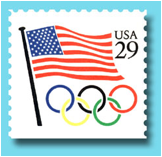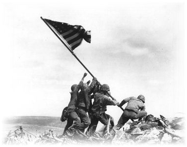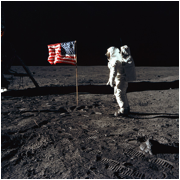
American Flag History
During the earliest days of the United States, the situation regarding Flags was much different than it is today; there was no one single design, nor was there much conformity in flags even within a single design specification. Striped flags became popular even before the Revolutionary War broke out. The first U.S. flags retained the symbols of the mother country, in the hope of reconciliation. After 1777 and the adoption by Congress of the Stars and Stripes, three basic "sub-designs" used for different purposes evolved; the thirteen stripes used quite unofficially as a " Merchant Flag ," the design authorized by Congress on June 14th, 1777 and often referred to as the " Marine Flag ," used by our Navy; and the " Standard of the United States ," utilized primarily at the beginning by the army.

The First Official American Flag: This 13-Star Flag became the Official Flag republic flag on June 14th, 1777 as the result of a resolution of the continental congress. Much evidence exists pointing to Congressman Francis Hopkinson as the person responsible for its design. Each of the 13 founding Colonies was represented by 1 star and 1 stripe.

The American Flag represents the United States of America and has progressed through many designs. Each official design represented the change in the number of states in the union.
Our Current Flag is composed of 7 Red and 6 White Stripes, 50 Stars on a field of Blue.
The St. George Cross was carried to the New World by most of the early English explorers.

The "King's Colors" was the flag raised by the Jamestown settlers in 1607. Its design combined the St. George cross with the Scottish cross.

The Continental Flag was used by American forces at the Battle of Bunker Hill in 1775.

The Gadsen flag was flown early in 1776 by the Commander-in-chief of the Continental Fleet.

The Grand Union was unofficially the first national flag of the United States. It was first flown in 1776.

The Betsy Ross was the first official United States flag, declared so by Congress on June 14, 1777. It is called the Betsy Ross because the seamstress is supposed to have sewed the first one.

The Bennington was flown over the military stores at Bennington, Vermont, the location of an important victory of the colonists over a British raiding force.

The British Red Ensign was the flag that Cornwallis surrendered under at Yorktown in 1781.

The Star-Spangled Banner was the flag that inspired Francis Scott Key to compose the song that became the National Anthem. It has 15 stars and 15 stripes.

Here we see the actual "Star-Spangled" flag as it looked before and during its restoration at the National Museum of American History
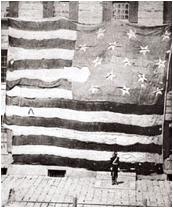
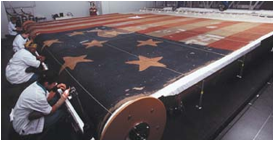
The earliest known photograph of the flag, arranged by historian George Preble, was taken at the Boston Navy Yard in 1873. Pictured also are conservators at the Smithsonian's National Museum of American History painstakingly restoring the Star-Spangled Banner.
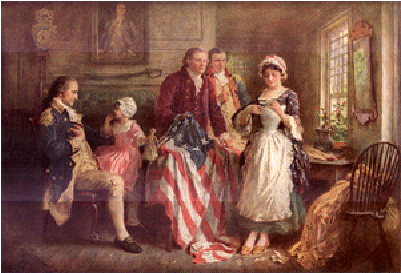 It was a big day for a little nation in May 1776 when Betsy Ross is said to have been visited by three members of a secret Continental Congress committee, asking her to sew the first flag.
It was a big day for a little nation in May 1776 when Betsy Ross is said to have been visited by three members of a secret Continental Congress committee, asking her to sew the first flag.
Until that time, the various colonies had used many different flags, many of which were quite similar to Britain's Union Jack. Flags were considered important for troop morale, and the shaky new nation clearly needed a symbolic source of unity.
On June 14, 1777, Congress adopted the flag with then ringing words: " Resolved: that the flag of the United States be 13 stripes, alternate red and white; that the union be 13 stars, white in a blue field, representing a new constellation.
Flag Day was celebrated in various places, starting in the 19th century. But, it was not until August 3, 1949, that President Truman signed legislation making June 14, Flag Day, a day of national observance.

What is with the stripes, and why did they choose Red, White & Blue. Listen to the answer here:
